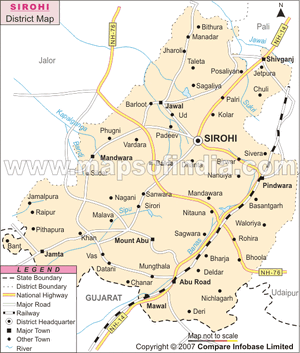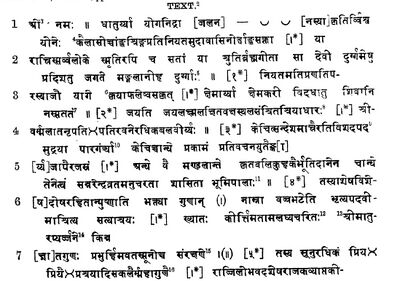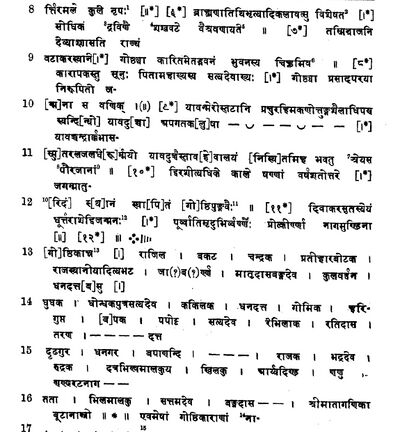Basantgarh

Basantgarh (बसंतगढ) (Vasantgadh) is a town in Pindwara tahsil of Sirohi district in Rajasthan.
Variants of name
- Basant Garh (बसंतगढ)
- Basantagadh (बसंतगढ)
- Basantgarh (बसंतगढ)
- Vasantagadha वसंतगढ़ , राज, (AS, p.837)
- Vasantgadh (वसंतगढ)
- Vasisthapura (वसिष्ठपुर)
- Vat (वट)
- Vata (वट)
- Vatakara (वटकर)
- Vatanagara (वटनगर)
- Vatanagra (वटनगर)
- Vatapura (वटपुर)
- Vatasthana (वटस्थान)
- Vetaleara
History
Basant Garh eight kms to the South of Pindwara, is Situated on a river named Saraswati. Its old names, as known from various sources, were Vetaleara, Vatasthana, Vatanagra, Vata, Vatapura and Vasisthapura. This place was called Vata on account of the banian trees, which are found in abundance. In the eleventh century, it was believed that once, under the banian trees there stood a Sacrificial hermitage of Vasistha. Vasistha is said to have erected the temple of Arka and Bharga, and with the aid of the architect of the Gods, founded the city called Vata adorned with ramparts, orchards tanks and lofty mansions. It was therefore called Vasisthapura.
In course of time, this hermitage of vasistha developed into a prosperous town, as is clear from the ruins of the palatial buildings of the kings and the temple of different religions. Vasanthgarh, the city of great antiquity must have been in existence long before the first half of the Seventh Century A.D. In 625 A.D. it was held by Rajilla & father Vajrabhata Satyasraya was also a feudatory of the same king. Rajjilla protected Mt. Arbuda and he had his capital at Vasanthgarh.
The king Varmalata is certainly identical with the king of the same name where Prime Minister Suprabhadeva was the grand father of the famous poet Megha of Shrimala. Hence Varmalata seems to be the ruler of Shrimala. Further, it is known from the Nisithachurni, In 676 A.D. that the siluer Cain Current in Shrimala at that time was well know by the term Varmalata after its ruler.
In course of time Vasanthgarh seems to have fallen into decay and forced its inhabitants for migration to different places from the Samoli inscription dated 646 A.D... It is known that Mahajana Community headed by Je(nta)ka who had migrated from Vatanagara, started an agara in Aranyakupagiri, which became a source of livelihood for the people. From the inscription of Lahini well, dated 1042 A.D., it is known that Bhavagupta, one of the predecessors of Vigraharaja, the deceased husband of Lahini ruled over this territory, and he restored a temple of the sun. Vigraharaja was fourth in succession from Bharagupta. He ruled in 1042 A.D., and therefore, Bhavagupta, his predecessor, must have lived about 100 years earlier than Vigrahara, i.e. 942 A.D. The successor of Bhavagupta was Samgamraja, who ruled Badari in Vamsaratha. This change of capital was perhaps due to some political upheaval, which brought further ruin to this palace perhaps, as a result of it, a person who is originally belonged to this place, came to Ahar in Mewar and built the temple of Nanigasvami in 977 A.D... In 1042 A.D., it was the capital of Parmar ruler Purnapala, son of Dhanduka. His younger sister Lahini, after the death of her husband, went to Vasantgarh, the capital of ancestors, to live with her brother. She settled down there, rebuilt the dilapidated temple of the sun and restored a step-well for convenience of the public. This well is still Lanvava (Lahinivapi). In the medieval period, Vasantgarh was destroyed by muslim invasions and, therefore, it was deserted. In the middle of the 15th century, it was included in the dominations of the Guhila king, kumbhakarna. He rehabilitated the old town by inviting people from different places for settlement, and provided several facilities to them. Under patronage of the early hindu rulers, both Brahmannical and Jain religious flourished highly. The main old temples, as known from the inscriptions, were of Kshemarya, Sun, Brahma and the Jain Tirthankars. These temples were not later than 7th century A.D... An inscription of 625 A.D. records that while Rajilla, a feudatory of Varmalata and the ruler of the territory round Mount Abu was reigning at Vasantgarh, a temple of the Goddess Keshemarya was erected by a trader named Satyadeva at the direction of the town assembly. There can be little doubt that the Keshemarya of this inscription is Khimelamata, near whose shrine, the stone was discovered.
Reference - sirohi.nic.in/stemples.htm
Basantgarh Inscription of Varmalata of 625 AD : Hindi
बसंतगढ का लेख ६२५ ई.
सिरोही जिले का बसंतगढ़ का वि.सं. ६८२ का लेख[1] राजा वर्मलात के समय का है. इस लेख से पता लगता है कि उक्त संवत में वर्मलात का स्तम्भ राज्जिल जो वज्रभट (सत्याश्रम) का पुत्र था अर्बुद देश का स्वामी था. सामन्त प्रथा पर इस लेख से कुछ प्रकाश पड़ता है.
शिलालेख के लाइन 13-16 में कुछ गोष्ठिकारों के नाम वर्णित हैं जैसे राजिल, बकट, चंद्रक, प्रतीहार बोटक, राजस्थानीय आदिल्य भट, मातृदास बंगदेव, कुलवर्धन, धनदत्त बसु, धुधक, धोंधक पुत्र सत्यदेव , ककिलक, धन दत्त, गोमिक, हरिगुप्त, बपक, पपोट, सत्य देव, रेभिलाक, रतिदास, तरण, दृढगुर, धनगर, बपाणन्दि, राजक, भद्र देव, रुद्रक, दत्रभिल्वमालकुय, खिलकु, आर्यदिंड, णणु, णण्णरटनाग, तता, भिलमालकु, सत्तम देव, बंग दास ,
Vasantgarh Inscription of Varmalata of V.S. 682 (625 AD) : English


Reference - Epigraphia Indica, Vol.IX,pp.189-192, By D R Bhandarkar, Poona
[Page-189] Last year a summary of this inscription was published by Prof. Kielhorn, with a promise to publish the full text on some future occasion. The impressions sent by Pandit Gaurishankar Hirachand Ojha of Udaipur were not sufficiently clear for that purpose. During the touring season ending March 1906, my work chiefly lay in the Sirohi State. I was thus able to inspect the original stone in person and take the best possible impressions. When the summary was afterwards published on my return to head-quarters, I sent my impressions to Prof. Kaelhorn. But, as circumstances arose which prevented him from publishing them, the impressions were
[Page-188-89] NA
[Page-190] Mata to whom the temple was dedicated. The second name is Pratihara Botaka, the first of which words I think signifies the race. Botaka was thus a Pratihara, i.e. Padiyar, and this is the earliest instance of the denomination Pratihara occurring in an inscription. The third name is Rajasthaniya Adityabhata, the first part of which is unquestionably an official designation meaning the foreign secretary. Prof. Kielhorn thinks that the name of Varmalata spoken of in our inscription as paramount sovereign settles the date of the poet Magha. It would be impossible not to agree with him when he says, that, out of the numerous forms found in the manuscripts of the Sisupalavadha, of the name of the king at whose court Magha's grandfather Suprabhadeva is stated to have held the office of prime-minister, the variant Varmalata is to be selected as the most likely one. But to the identification of this prince with the Varmalata of our inscription,, supposing the date V.E. 682 to he correct, it is possible to raise an objection. As every student who has read the Sisupalavadha knows, Magha in his work distinctly alludes to the two grammatical treatises, the Kasikavritti and its commentary called Nyasa. The former is the joint production of of Jayaditya and Vamana, and, with regard to the former author, the Chinese traveller I-tsing informs us in unmistakeable terms that he died about A.D. 661-662. It should, moreover, be borne in mind that the author of the Nyasa was Jinendrabuddhi, who like Jayaditya was a follower of the Buddha. And it is inconceivable that I-tsing, one of whose principal objects in coming to India was to collect information about Buddhist authors, could have passed him over in silence, if the latter had flourished before A.D. 695 when the Chinese traveller's departure from India took place. The conclusion is, therefore, irresistible that the author of the could not have lived before the first half of the 8th century. Magha, therefore, has to assigned to the latter part of the 8th century. This line of argument adduced by Prof. Pathak appears to me to be worth considering. Dr. Konow, however, informs me that he does not think it convincing. He says, "the argumentum ex silentio is always unsafe, and, even if we admit that Jinendrabuddhi cannot have written before A.D. 695, that does not disprove Professor Kielhorn's identification of our Varmalata with the king whose minister Magha's grandfather was. Our inscription may very well date from a time previous to his appointment as minister, and it does not, at any rate, make it impossible to bring Magha down to the first twenty years of the 8th century. There is nothing to hinder us from supposing that Jinendrabuddhi flourished about A.D. 700. The alleged reference to his work in the Sisupalavadha -would, I think, be more intelligible if we suppose it to have been a new work at the time when Magha wrote his poem."
I quite accept Dr. Konow's main conclusions. But I agree with Professor Pathak that the argumentum ex silentio carries some weight in this particular instance. One of the chief objectives of I-tsing had in view was to gather all available information about Buddhist authors in India, And, when we consider that he had even mentioned his own contemporaries, it is very unlikely that he should have failed to notice Jinendrabuddhi, if the latter had actually achieved fame in his time. As pointed out by Dr. Konow, there is, however, nothing to prevent us from considering Magha and Jinendrabuddhi as contemporaries. The mere fact that one author quotes another one, only shows that he knows him, and not necessarily that he belongs to a later time. Magha, and Jinendrabuddhi can, therefore, very well both have lived at the beginning of the eighth century, and Professor Kielhorn's identification of the two Varmalatas remains unaffected by Professor Pathak's argument.
[Page-191] The place Vata where feudatory price Rajjila reigned is Basantgarh itself. This is clear from the fact that the temple to Kshemarya, said in the inscription to have been built by the goshti of Vata is no other than temple of Khimel mata in Vasantgarh of which the inscription was part. This conclusion is confirmed from the fact that temples dedicated to Sun and Brahma mentioned existing in Vatapura in the inscription of Purnapala dated VE 1099 , are still existing at Basantgadh. A slightly different name for the place Vatakara occurs in L. 9.
Vasantgadh Inscription of Purnapala V.S 1099 (1042 AD)
Reference - Epigraphia Indica, Vol IX, pp.10-15, By Prof. P. Kielhorn, C.I.E.; Gottengen
About the year 1840 the stone, which bears this inscription, was taken by Captain T. S. Burt from a tank at Vasantgadh in the Sirohi State of Rajputana, and the inscription, was published in Journal of Asian Society of Bengal, Vol. X. p. 664 ff., from a very unsatisfactory transcript prepared by Pandit Kamalakanta. For a long time the stone seems to have been lost sight of ; but it has lately been rediscovered by my indefatigable friend, Mr. Gauriahankar Hirachand Ojha of Udaipur, and is now deposited at the town of Sirohi. I re-edit the text from impressiona which have been kindly sent to me by Mr. Ojha.
The inscription contains 23 lines of writing. The characters generally differ little from the ordinary Nagari, but they include a few signs which, are peculiar to the earlier northern inscriptions. The letter b everywhere is denoted by a sign of its own, and the secondary a is often written by a superscript line.
The object of the inscription is, to record that a queen named Lahini (लाहिणी), a younger sister of the Paramara Purnapala and widow of a king Vigraharaja, at Vata (वट) Vatanagara (वटनगर), Vatapura (वटपुर)] restored an ancient temple of the Sun, and restored or founded a tank (vapi), apparently the very tank where this record has been found. And the inscription is divided into three parts, the first and second of which give the genealogies of Lahini and Vigraharaja, while the third glorifies the town Vata and the pious work executed there by the widowed queen. The whole is introduced by two verses, in one of which (so far as it is preserved) the author pays homage to Maheshvara (Siva), Prachetasa (the poet Valmiki), and Vani (the goddess of eloquence), while in the other he invokes the protection of the god Hari (Vishnu).
Verse 3 relates that through the anger of (the sage) Vasishtha there was produced a youth, or prince (kumara) from whom the Pramara (or Paramara) family took its origin. In his lineage there was Utpalaraja (उत्पलराज); from him sprang Aranyaraja (अरण्यराज ), and from him Adbhutakrishnaraja. His son (or, if a name should have been lost at the commencement of line 4, his son's son.) was Mahipala (महिपाल), and from him sprang Dhandhuka (धन्धुक ). To Dhandhuka there was born from his wife Amritadevi Purnapala (अमृतादेवी पूर्णपल ), who ruled the Arbuda territory. In his reign, his younger sister Lahini was married by king Vigraha (Vigraharaja).
Vigraharaja's genealogy, in verse 12, commences with a twice-born named Yota, who by his bravery acquired the title of king (bhupa). In his lineage there was the king (nripa) Bhavagupta, who, after restoring the temple of ‘the Sun dwelling at Vata', reigned at Vata. In his lineage, again, 'there was Samgamaraja, who ruled Badari in Vamsaratha. From him sprang Durlabharaja; from him, Chacha ; and from him, Vigraharaja, who, as stated already, married Lahini. After his death, his widow went to her brother's home, and was settled at the town of Vata which in the course of time had fallen into decay.
The town of Vata (Vata-nagara, Vata-pura) is glorified in verses 20-25. Here it will be sufficient to say that it is stated to have been founded by the sage Vasishtha, that it was situated on a river named Sarasvati, and that its inhabitants are described as devoted to the worship of the Sun. That the queen Lahini restored there an ancient temple of the Sun and restored or founded a tank, has been already mentioned.
The inscription (according to verses 33 and 34) was composed by the Brahman Matrisharman, the son of Hari, and engraved by Sivapala, the son of the sutradhdra Deuka, who was the son of, the son of the sthapati ( ‘architect, carpenter,' etc.) Naga.
It ends (v. 35) with the date: the ninth tithi of the dark half of the month Nabha,i.e. shravana, the moon being in (the nakshatra) Mrigasiras, of the year (given in words) 1099 in the time of Vikramaditya, 'in the place' of Chitrabhanu. By this last expression I understand the author to say that the date fell in the Jovian year Chitrabhnu. This year can be combined with the Vikrama year 1099 only, when the latter is taken to be the expired Chaitradi Vikrama year 1099, and Chitrabhanu to be the Jovian, year so named according to the southern system. For that year the date would correspond to the 12th. August A.D. 1042.
The Pramara or Paramara chiefs mentioned in this inscription ruled the Arbuda-mandala, i.e. a tract of country called after Arbuda, the modem Mount Abu. They are probably closely connected with the Paramaras of Chandravati, mentioned, e.g., above, Vol. VIII. p. 201. Regarding Vigraharaja and his ancestors I cannot offer any remark.
The places Vata and Badari in Vamsaratha (v. 14) I am unable to identify. Vata must be an old place, being mentioned already in the Vasantgadh inscription of Varmalata of the [Vikrama] year 682, and in a somewhat earlier inscription which was found at the village of Samoli in the Bhomata district of Mevad, and of which Mr. Ojha has sent me impressions. If not identical with Vasantgadh itself, it must be looked for close to it.
वसंतगढ़
विजयेन्द्र कुमार माथुर[2] ने लेख किया है ...वसंतगढ़ राजस्थान में आबू के निकट स्थित है। 9वीं शती ई. में जैनों का यह महत्त्वपूर्ण तीर्थ स्थान था। यहाँ के खंडहरों से प्राप्त उस समय की अनेक धातु की प्रतिमाएं पीड़वाड़े के जैन मंदिर में रख दी गई हैं।
Jat Gotras
Rajliye (राजलिये) gotra of Jats are descendants of Rajil (राजिल). ([3]
Brahma temple
Basantgarh is known for Brahma temple. The Brahma temple of Vasantagarh (Sirohi) had a two-armed and three-faced figure of the god.
Notable persons
External links
References
- ↑ डॉ गोपीनाथ शर्मा: 'राजस्थान के इतिहास के स्त्रोत', 1983, पृ.47. Epigraphia Indica, Vol. 9, pp.191-92
- ↑ Aitihasik Sthanavali by Vijayendra Kumar Mathur, p.837
- ↑ Dr Mahendra Singh Arya, Dharmpal Singh Dudee, Kishan Singh Faujdar & Vijendra Singh Narwar: Ādhunik Jat Itihasa (The modern history of Jats), Agra 1998, p. 278
Back to Jat Villages

